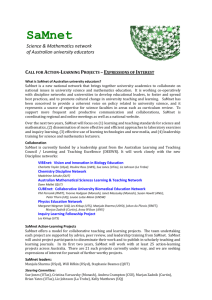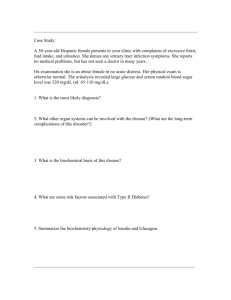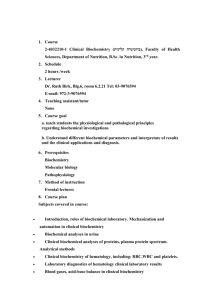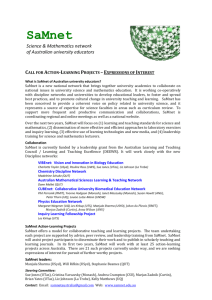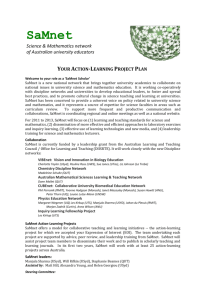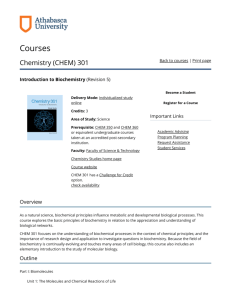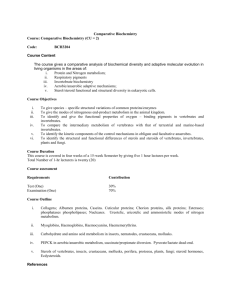EOI_form_JVanderleli..
advertisement
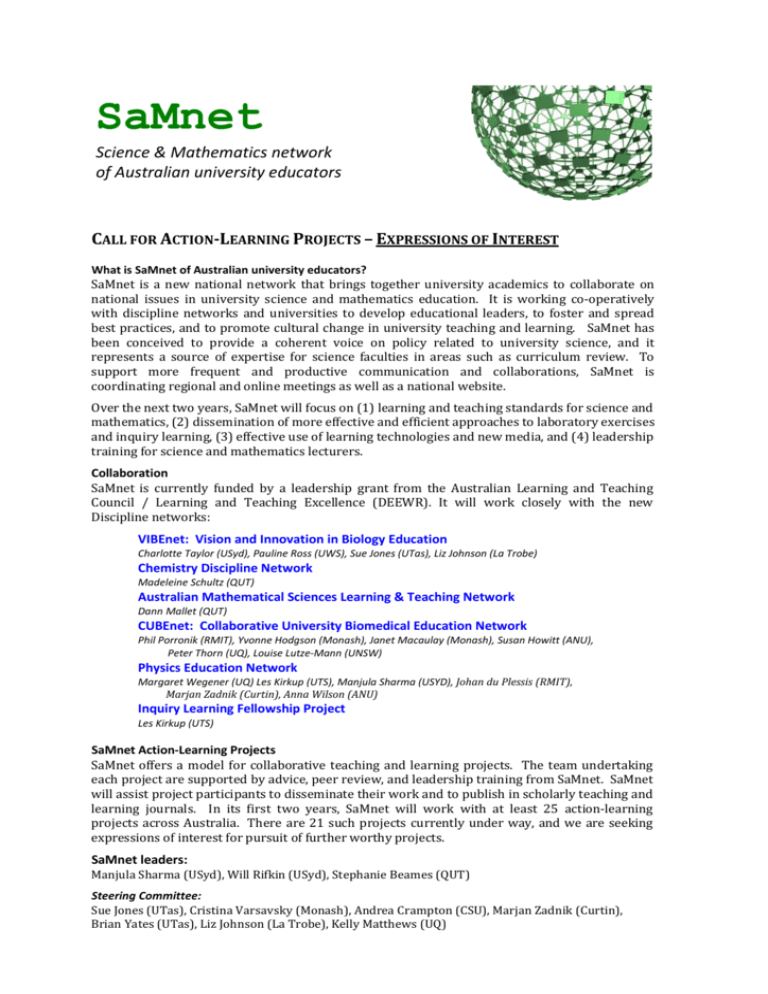
SaMnet Science & Mathematics network of Australian university educators CALL FOR ACTION-LEARNING PROJECTS – EXPRESSIONS OF INTEREST What is SaMnet of Australian university educators? SaMnet is a new national network that brings together university academics to collaborate on national issues in university science and mathematics education. It is working co-operatively with discipline networks and universities to develop educational leaders, to foster and spread best practices, and to promote cultural change in university teaching and learning. SaMnet has been conceived to provide a coherent voice on policy related to university science, and it represents a source of expertise for science faculties in areas such as curriculum review. To support more frequent and productive communication and collaborations, SaMnet is coordinating regional and online meetings as well as a national website. Over the next two years, SaMnet will focus on (1) learning and teaching standards for science and mathematics, (2) dissemination of more effective and efficient approaches to laboratory exercises and inquiry learning, (3) effective use of learning technologies and new media, and (4) leadership training for science and mathematics lecturers. Collaboration SaMnet is currently funded by a leadership grant from the Australian Learning and Teaching Council / Learning and Teaching Excellence (DEEWR). It will work closely with the new Discipline networks: VIBEnet: Vision and Innovation in Biology Education Charlotte Taylor (USyd), Pauline Ross (UWS), Sue Jones (UTas), Liz Johnson (La Trobe) Chemistry Discipline Network Madeleine Schultz (QUT) Australian Mathematical Sciences Learning & Teaching Network Dann Mallet (QUT) CUBEnet: Collaborative University Biomedical Education Network Phil Porronik (RMIT), Yvonne Hodgson (Monash), Janet Macaulay (Monash), Susan Howitt (ANU), Peter Thorn (UQ), Louise Lutze-Mann (UNSW) Physics Education Network Margaret Wegener (UQ) Les Kirkup (UTS), Manjula Sharma (USYD), Johan du Plessis (RMIT), Marjan Zadnik (Curtin), Anna Wilson (ANU) Inquiry Learning Fellowship Project Les Kirkup (UTS) SaMnet Action-Learning Projects SaMnet offers a model for collaborative teaching and learning projects. The team undertaking each project are supported by advice, peer review, and leadership training from SaMnet. SaMnet will assist project participants to disseminate their work and to publish in scholarly teaching and learning journals. In its first two years, SaMnet will work with at least 25 action-learning projects across Australia. There are 21 such projects currently under way, and we are seeking expressions of interest for pursuit of further worthy projects. SaMnet leaders: Manjula Sharma (USyd), Will Rifkin (USyd), Stephanie Beames (QUT) Steering Committee: Sue Jones (UTas), Cristina Varsavsky (Monash), Andrea Crampton (CSU), Marjan Zadnik (Curtin), Brian Yates (UTas), Liz Johnson (La Trobe), Kelly Matthews (UQ) SaMnet of Australian university educators Contact: Email: samnetaustralia@gmail.com Web: www.samnet.edu.au 2 SaMnet of Australian university educators Action-Learning Project -- Expression of Interest Send EOI to SaMnetAustralia@gmail.com by 9 April 2012. Selection criteria: A. Emphasis on changing how a collective teaches B. Rationale and evidence on why the change is needed C. Potential for impact on applicant, teammates, school, faculty, and discipline 1. Project title: Improving student performance and understanding in biochemistry: Assessment to develop a creative multimedia expressions of biochemical theory. 2. Applicant Team leader – Are you (tick one or more): X Innovative (or junior) academic - Sees the change that is needed Senior Academic - Understands the challenges of creating change Educational developer, Academic staff developer, or equivalent Knows cases beyond the faculty and relevant concepts from the literature Associate Dean (Education) or equivalent - Has faculty–wide insight and knows priorities Name: Jessica Vanderlelie j.vanderlelie@griffith.edu.au Discipline: Biochemistry E-mail: Faculty: Health 3. Project Scope (the collective being addressed) Target Degree programs, Years of study, and Disciplines Second Year, Bachelor of Biomedical Science, Health Science, nutrition and dietetics, biochemistry (Biochemistry : metabolism) discipline 4. Project Description (rationale and evidence) Aims, Innovation, Rationale, Precedent - What do you want to change (e.g., nature of lab work in second year) and why Project Overview Metabolism 2011MSC is a second semester second year course in the School of Medical Science. The traditional lecture plays an important role in biochemical education though in an attempt to create an engaging and intellectually stimulating learning experience for students and to facilitate a shared experience of learning, the implementation of a group based assessment item is being evaluated. The assessment item (Appendix 1) encourages students to develop their own collection of multimedia resources. The task provides students with an opportunity to creatively explore fundamental biochemical concepts and encourages engagement, deeper understanding, peer 3 SaMnet of Australian university educators collaboration and entertainment with an overall aim to improve learning outcomes for students. This project aims to answer the following research question; Can a creative multimedia based assessment item increase student engagement, participation and performance in a second year biochemistry course? Aims • To facilitate the exploration of fundamental biochemical concepts in a creative way that enhances and supports deeper understanding. • To enhance student engagement and the enjoyment of metabolic biochemistry. • To encourage students to participate in groups and develop as independent learners. • To develop enduring relevance and deep learning in second year biochemistry. • To assess the effectiveness of the creative task in supporting student learning and overall performance in the course. Evaluation A number of evaluation methodologies will be implemented to assess the projects relevance to student learning outcomes and capacity to engage student learning, these will include; 1. Evaluation questionnaire with both quantitative and quantitative questions that will cover; overall student satisfaction with the assessment task; the effectiveness of the assessment task in facilitating student learning; the effectiveness of the assessment task in engaging the student; the usefulness of the assessment task as a learning tool; the likelihood that the student will draw on the resources developed by other students; Qualitative feedback on what students about the assessment task; Qualitative feedback on what students did not like about the assessment task. 2. Student Evaluation of Course data for the course will be used as a comparison with previous years to determine the impact of the assessment item on overall student satisfaction with the course. 3. Comparison of the overall performance of students in the final examination with that of previous years (2009, 2010, 2011) who have sat a similarly structured exam that examines the fundamental concepts in a long answer more conceptually based format without the inclusion of this assessment item. Appendix 1 The Assessment Task The assessment is designed to be a semester long group based project worth 10% of the final grade, with 5 students in each group. The assessment task will involve the production of a 5 minute (maximum) creative presentation using digital media, in the form of a song, animation, movie/role play, integrated flow chart/concept map with explanations that will be uploaded on to the discussion board in the Metabolism Learning @ Griffith blackboard site. Each group will be asked to pick one topic from a list of 7 content areas that cover of the fundamental concepts/pathways of biochemistry and map to clearly defined learning objectives for the course. The content areas and topics will include; 1. Stage 1 Metabolism : Digestion, absorption and transport of carbohydrates, protein or fats 2. Carbohydrate Metabolism : Glycolysis and gluconeogenesis 3. Protein Metabolism : Transamination/deamination reactions, urea cycle, protein biosynthesis 4. Lipid Metabolism : Lipid catabolism and lipid biosynthesis 5. Citric Acid Cycle : Reactions of the citric acid cycle, glyoxylate cycle, pentose phosphate pathway 6. Electron Transport chain : Reactions of the electron transport chain, regulation/inhibition 4 SaMnet of Australian university educators 7. Integration of Metabolism : Hormonal regulation of metabolism Students will be required to submit an outline of their project by Week 7 that will be reviewed by the assessment team. The final assessment piece will be submitted in Week 12 and students will be given until the Monday of Week 13 to evaluate each other’s assessment items using the rate post function in the discussion board. A two hour session in the final week of teaching will be set aside to review and discuss the presentations as a class group that will give the class the opportunity the see examples of the best presentations and for the convenor to link student work to the revision of the course. There will be three methods of assessment that will combine to form the final grade; 1. Class Wide Peer Assessment (10%) • Students will be required to grade each presentation using the rate post function on the discussion board. • Each group member will be required to rate at least 10 projects. 2. Intra Group Peer Assessment (10%) • Within the groups students will be required to peer assess each member of their group in terms of input and willingness to participate. 3. Examiner based • Part 1 (40%) • Outlines submitted in week 7 will be evaluated and written feedback provided to each group. • Part 2 (40%) • Examiner will post a general rating on the discussion board after each post prior to week 13 to give students a guide to the technical accuracy of each post. (10%) • At the completion of the project examiners will assess the groups on the accuracy and quality of the presentation and detailed written feedback will be given to each group. (30%) 5. Outcomes (potential for impact) Expected outcomes if successful (e.g., higher pass rates), why those outcomes, impacting how many students (estimated) Outcomes and Deliverables It has been expressed that one downfall of a didactic teaching methodology is that students generally do not acquire the skills to apply knowledge obtained from one area of biochemistry in order to gain insight into another and therefore biochemical knowledge is treated as non-overlapping sets of information (Palmer, 1986). It has been proposed that a teaching approach that constantly reinforces the concept of integration of knowledge is required (Palmer, 1986) to transform student epistemological beliefs and facilitate self directed, deeper approaches to learning. In addition to traditional lectures, innovations in the delivery and support of a traditional lecture format through the use of advanced organisers (Torres, 1993), mnemonics (Patel & Shastri, 1996) web technology (Traver et. al., 2001) and audio tutorials, videotapes and animations (Wood, 1992; Leader, 1979; Lightfoot & Steffen, 1977; Postlethwait et al., 1972) have proven effective in increasing student engagement in biochemistry education. 5 SaMnet of Australian university educators Such positive uses of technology in the biochemistry classroom have led to the development of visualisation tools such as molecular models, metabolic maps, symbolic pathways and multimedia/graphical representations of pathways. However more recently consideration has been given to a student’s ability to interpret and synthesise the information presented and the necessity for student to be taught to develop their visual literacy(Schonborn & Anderson, 2006). Schonborn and Anderson (2006) identified ten fundamental guidelines for the teaching and learning of visual literacy, the current project makes use of a number of these guidelines to encourage students to interpret multiple sources of content and synthesise the information gained into their own unique creative representation of biochemical theory. Not only will this encourage depth of understanding it enhances students’ visual literacy that goes beyond what would be achieved if students are asked to write summaries of content(Gobert & Clement, 2006). By constructing their own visual expression of a biochemical pathway students also become more able to process other abstract visual representations (Schonborn & Anderson, 2006) that will assist them not only in their studies of biochemistry but to become better metacognitive thinkers (Postlethwait et al., 1972) It is anticipated that this will have a positive impact on the learning outcomes of the 150 students who participate in this course each year in a number of ways; • By encouraging students to examine, critically evaluate and synthesise knowledge concerning biochemical pathways and use what they have learnt to develop a creative expression of the theory to be shared with their peers. • The assessment task will also encourage students to work as they go rather than leaving their study to the last minute • By discussing what they know about a particular pathway with other members of their group they will be able to increase the depth of their understanding. • By embedding this assessment item into Metabolism 2011MSC it diversifies the assessment strategy of the course and allows students to take the time to deeply consider a particular biochemical pathway and also encourages the development of visual literacy (Schonborn & Anderson, 2006) that can then be used to critically evaluate the postings made by other groups. Improve knowledge of biochemisty that will be translated into improved scores on the final examination and overall for the subject. • Deeper understanding of biochemical concepts and their integration that will assist with the answering of conceptual based long answer and case based questions on the final examination. • Promote innovation and creativity in the students and also facilitate the development of effective communicators and team members . • The detailed evaluation strategy will provide the framework for any alterations that need to be made to the assessment task and ensure the enduring success project. In addition to the development of skills as mentioned above other project deliverables include • Students will also have a set of developed resources that they are able to draw upon for their study • Developed learning object to be loaded onto the web that showcases the top ten assessment items. • Preparation and submission of findings in conference papers and journal articles 6 SaMnet of Australian university educators 6. Project Implementation What capabilties you hope to build, what do you want to learn about leading change It is proposed that this project will develop a range of capabilities in the students who undertake the project as mentioned above. Additionally I percieve the development and implementation of this project will further enhance my capability to perform research in teaching and learning. This project will also assist me in demonstrating the benefit of creativity and innovation in tertiary education, particularly in biochemistry a field that is often appriached in a diadactic and traditional manner. This project also has the capacity for wide grneralisability as the importance of developing visual literacy is not limited to students of biochemistry. A report out of Brigham Young University suggests that the development of visual literacy is important to students of engineering, nursing, business, social and family sciences, the fine arts and communication (Christopherson, 1996). Although Christopherson (1996) makes an argument for a structure course designed to teach visual literacy, inroads may also be possible through structured assessment that facilitates the development of such skills. The current assessment concept although directly relevant to the education of biochemists could easily be translated to any subject where an emphasis is placed on the integration of multiple sets of information to achieve a coherent understanding. One would expect therefore that such a statement would apply to the vast majority of subject areas taught within the University. The design of the assessment task utilises established technologies and it would be logically considered that little addition infrastructure would be required for this style of assessment to be taken up by other courses/schools. 7. Comments or Questions • • • • What do you need to know? Where can you use assistance? It would be beneficial for me to have access to some support in leadership development. The Project was implemented in 2011 and I am in the process of writing up the findings, which were positive. I could utilise support in the publication process and any available assistance in the disemination of the project outcomes (ie conference funding) I am anticipating the assessment task will run again in 2012 and I intend to evaluate it again for comparison longitudinally. FAQ’s 0. Submitting the proposal Fill in the blanks. Just a line or two for each blank is sufficient. A full project plan is also welcome – pasted in or as an attachment. More than one EOI may be submitted from any individual, team, school, faculty, or university. 1. What counts as an Action-Learning Project / ‘change initiative’? The Action-Learning Projects are ‘change initiatives’ in that they are a way to address a problem that you see in your school or faculty. That could be a high dropout rate for majors or heavy emphasis on 7 SaMnet of Australian university educators final exams. An action-learning project can also be a way to disseminate a teaching strategy that you have developed or means to implement a new curriculum. For example, do you have a method for improving feedback to students that ought to be used more widely? What we are not counting as a ‘change initiative’ is an experiment in teaching that you are not planning to embed more broadly within your school or beyond. A change initiative takes an idea – an invention – and turns it into an ‘innovation’ – something that others are taking up. 2. What if I have already started the effort? It is fine if you have already started. These action-learning projects have been conceived to support people to do things that they want to do anyway, and to learn through this pursuit via our support. You are welcome to apply to SaMnet for assistance with a project that is already internally funded. SaMnet will also support a project funded by the ALTC fellowship in inquiry learning (c/- Les Kirkup) or a curriculum mapping effort with Beverley Oliver, to name two of many examples. 3. What if my Action-Learning Project has limited success? Null or negative results are viable options. SaMnet action-learning projects are not premised on your need to deliver 100-percent success. However, it is important to avoid ‘reinventing the flat tyre’, failing in a way that experienced hands (and the literature) would readily predict. Our action-learning projects are meant to increase your understanding of what it takes to lead change. You can learn to connect with the right people in the right way and to successfully navigate university politics. You can also learn through reflection on new experiences. The outcome of your effort is meant to be an increase in the capacity to drive change for you and your teammates. The record of what you tried, what worked, and what failed to work informs others who face similar challenges. 4. Can you provide support funding in small, unmarked bills? SaMnet provides support in the form of leadership development training, coaching, networking, and mentoring in both management and publication. There is no funding provided by SaMnet for teaching relief or research assistants. A SaMnet initiative is meant to be part of your weekly investment in research or administration. You will be rewarded with increased capability to persuade and lead. You will gain an internal sense of accomplishment. You will become part of a larger community, a movement to improve university teaching in science and mathematics in Australia. You will earn ‘points’ with publications. You will also contribute toward lifting the profile of academics who apply their intellect to improving teaching, a key objective of SaMnet. 5. Why me? The culture of teaching in university science and mathematics needs to change. Many people have developed new and more effective ways to teach and assess. The ALTC and its predecessors have funded more than 40 projects across the disciplines of science and mathematics. Such individual initiatives now need to gain traction locally, in your university, to instil sector-wide change. 15/3/12 -- altc nation leadership network in sci & maths \ action learning projects \ prop form \ EOI 8
